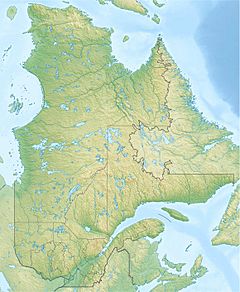Rivière du Rat Musqué facts for kids
Quick facts for kids Rivière du Rat Musqué |
|
|---|---|
| Country | Canada |
| Province | Quebec |
| Region | Chaudière-Appalaches |
| MRC | L'Islet Regional County Municipality |
| Physical characteristics | |
| Main source | Lac du Rat Musqué Sainte-Perpétue 330 metres (1,080 ft) 47°08′23″N 69°50′45″W / 47.139841°N 69.845828°W |
| River mouth | Grande Rivière Tourville 211 metres (692 ft) 47°13′11″N 69°53′25″W / 47.21972°N 69.89027°W |
| Length | 11.4 kilometres (7.1 mi) |
| Basin features | |
| Tributaries |
|
The Rivière du Rat Musqué, also known as the Muskrat River in English, is a river located in Quebec, Canada. It flows through the municipalities of Sainte-Perpétue and Tourville, both found in the L'Islet Regional County Municipality within the Chaudière-Appalaches region.
This river is an important part of a larger water system. It flows into the Grande Rivière, which then joins the Ouelle River. Finally, the Ouelle River empties into the mighty St. Lawrence River near Rivière-Ouelle.
About the Muskrat River's Journey
The Rivière du Rat Musqué begins its journey at a small lake called Lac du Rat Musqué. This lake is about 0.2 kilometres (0.12 mi) long and sits at an altitude of 322 metres (1,056 ft). It's located deep within the Notre Dame Mountains. A Canadian National train track runs along the south side of the lake.
From its source, the Muskrat River flows for about 11.4 kilometres (7.1 mi) through a beautiful forest. It first travels north and then northwest through Sainte-Perpétue. After about 5.3 kilometres (3.3 mi), it crosses into the municipality of Tourville.
Where the River Ends
The river continues its northwest path for another 6.1 kilometres (3.8 mi) through Tourville. It eventually meets the Grande Rivière on its east bank. This meeting point is very close to the edge of Saint-Damase-de-L'Islet.
What's in a Name?
The name "Rivière du Rat Musqué" means "Muskrat River" in English. It's named after the muskrat, a common animal found in wetlands and near rivers. The official name for this river was decided on December 5, 1968, by the Commission de toponymie du Québec, which is the organization responsible for naming places in Quebec.


